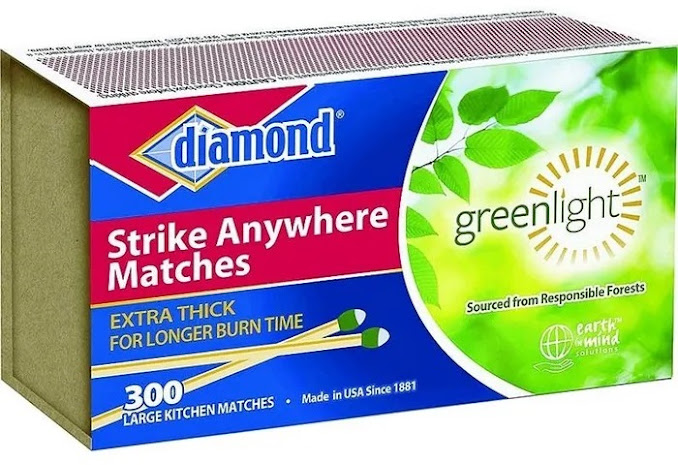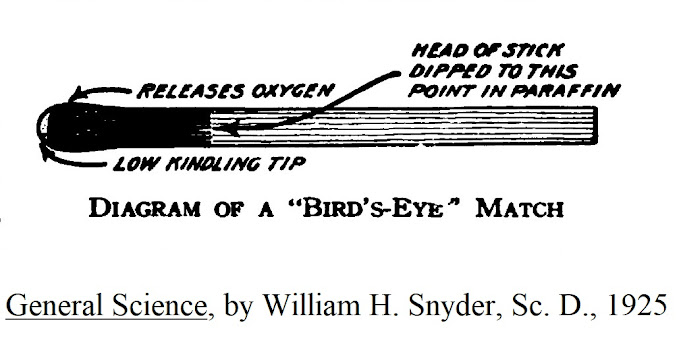Last
week we talked about what a marvelous invention the ordinary match is and how
it is equal to Tesla’s AC generator and motor, as a civilization changer, but
how are matches made and what makes one match a safety match and the other a strike-anywhere
matches?
To
make strike-anywhere or strike-on-box safety matches you need the following
components:
1) A gritty substance such as ground glass, to increase friction.
2) A low kindling temperature substance, such
as red phosphorus or phosphorous sesquisulfide.
Heat from friction changes the red phosphorus or phosphorous sesquisulfide
into white phosphorus, which is extremely flammable, and instantly reacts with
oxygen in the air, causing it to ignite.
3) An oxidizing
substance, like potassium chlorate, zinc oxide, or manganese dioxide, helps
the match to burn by decomposing to provide more oxygen. The heat from the white phosphorus oxidizing
sets off the decomposition of potassium chlorate to give oxygen.
4) An easily oxidizable substance that
ignites at a low temperature, such as sulfur compound, like lead hyposulfite,
iron sulfide (also known as pyrite, or “fool’s gold”), or antimony
trisulfide. The extra oxygen helps the
sulfur compounds ignite and burn, which ignites the wood and paraffin.
5) Paraffin to help sustain the flame.
6) Glue to bind all the other ingredients
together, except the paraffin. The glue
that binds the matchhead together is animal glue and is mostly made of a
protein collagen extracted by boiling bones, hides or horns. For the mixture of ignition, friction agents,
and oxidizing and oxidizable substances in the matchhead to work effectively,
they must be in close contact and uniformly distributed throughout the animal
glue. The glue also contains the various
starches, resins, and dyes that are part of the match.
How
you divide up these components, between matchstick and striking surface is what
determines if it is a strike-anywhere or strike-on-box safety match.
Strike-on-box safety matches
Besides
animal glue, the tip of the strike-on-box safety matchhead is made up of a gritty
substance to increase friction, an oxidizing substance, an oxidizable substance
and various starches, resins, and dyes.
The
on-the-box-striking-surface that is used to ignite the match is made of a substance
with a low kindling temperature and an oxidizable substance.
Strike-anywhere matches
Besides
animal glue, the tip of the strike-anywhere matchhead is made up of a gritty
substance to increase friction, a small amount, about 3%, of a low kindling
temperature substance, an oxidizing substance, an oxidizable substance and
various starches, resins, and dyes.
The
tip or “bird’s eye” of the strike-anywhere match is made up of a gritty
substance to increase friction, a larger amount, about 24%, of a low kindling
temperature substance, an oxidizing substance, an oxidizable substance and
various starches, resins, and dyes. .
Putting the match on the stick
Wooden
matchsticks are made of white pine or aspen wood and have an ignition
temperature which varies widely depending on the species of wood, its size,
moisture content, etc., and is usually between 400o to 500o
(204o to 260o C).
The common matchstick is first dipped in a dilute aqueous solution of
ammonium phosphate, a fire retardant chemical, which slows the burning rate of
the wood and prevents after-glow. The
matchsticks are then taken through a drying chamber and while still hot are
dipped into molten paraffin wax. The
first application of matchhead material is applied
to the matchstick and then the matches are sent back through a drying chamber.
If
the matches are going to be strike-anywhere matches, then the next step is the
application of the ignition material onto the tip of the matchhead.
At
this point both types of matches are often dipped in formaldehyde to render the
glue in the matchhead material more resistant to moisture and then the matches
are dried for the final time and boxed up.
Putting the match in the book
Book
matches are both similar and different from their close cousins the
strike-on-box safety match. They are made
from a specially made cardboard, cut into strips 1-7/8
inches (4.75 cm) wide, with tear-off splints 1-3/8 inches
(3.5 cm) cut into it. The cardboard is
then dipped in molten paraffin, dipped into strike-on-the box safety matchhead
material, dried, and stapled into covers, the bottom of which is covered in a striking surface material.
And
now we know how that most marvelous invention, the match is made, and what
makes one match a safety match and the other a strike-anywhere match. So next time you light one, take a second to
consider what an awesome invention it truly is.
Don’t forget to come back next week to check out the next article.
I
hope that you continue to enjoy The Woodsman’s Journal Online and look for me
on YouTube at BandanaMan Productions for other related videos, HERE. Don’t forget to follow me on both The
Woodsman’s Journal Online, HERE,
and subscribe to BandanaMan Productions on YouTube. If you have questions, as always, feel free
to leave a comment on either site. I
announce new articles on Facebook at Eric Reynolds, on Instagram at bandanamanaproductions,
and on VK at Eric Reynolds, so watch for me.
That
is all for now, and as always, until next time, Happy Trails!
Notes
Sources
American Gas Journal;
“Lesson 101...Combustion”, January 2, 1926, Volume 124, No. 1, American Gas
Journal, page 7, https://books.google.com/books?id=BZtijHmlkH0C&pg=PA7&dq=how+fast+do+matches+ignite&hl=en&newbks=1&newbks_redir=0&sa=X&ved=2ahUKEwiXs5mPm5yAAxUrEFkFHas8Bbo4UBDoAXoECAkQAg#v=onepage&q=how%20fast%20do%20matches%20ignite&f=false,
accessed July 22, 2023
Caldwell, Otis W., Ph.
D.; and Meier, W. H.D., Ph. D.; Open Doors to Science with Experiments,
[Ginn and Company, New York, 1926], page 106 to 111, https://books.google.com/books?id=spQNAQAAIAAJ&pg=PA111&dq=%22strike+anywhere+match%22&hl=en&newbks=1&newbks_redir=0&sa=X&ved=2ahUKEwiAzJemg4D9AhVyEFkFHS-ZCj44PBDoAXoECAUQAg#v=onepage&q=%22strike%20anywhere%20match%22&f=false,
accessed July 18, 2023
Greer, Carlotta C., and
Bennett, J. Cora; Chemistry for Boys and Girls, [Allyn and Bacon, New
York, 1925], page 693, https://books.google.com/books?id=fO1EAAAAIAAJ&pg=PA692&dq=%22strike-anywhere+match%22+chemistry&hl=en&newbks=1&newbks_redir=0&sa=X&ved=2ahUKEwjSis7I5YT9AhXWMlkFHQkXB54Q6AF6BAgCEAI#v=onepage&q=%22strike-anywhere%20match%22%20chemistry&f=false,
accessed July 22, 2023
Hough,
Walter; Fire-Making Apparatus in the United States National Museum,
[Government Printing Office, Washington D. C., 1890], page 542 to 578, https://books.google.com/books?id=eIpGAQAAMAAJ&printsec=frontcover&dq=how+long+to+create+a+fire+with+%22flint+and+steel%22&hl=en&newbks=1&newbks_redir=0&sa=X&ved=2ahUKEwiQn5mS15mAAxW3EVkFHQu-DckQ6AF6BAgCEAI#v=onepage&q=how%20long%20to%20create%20a%20fire%20with%20%22flint%20and%20steel%22&f=false,
accessed July 18, 2023
Snyder, William H., Sc.
D.; General Science, [Allyn and Bacon, New York,
1925], page 83 to 88, https://books.google.com/books?id=cttEAAAAIAAJ&pg=PA88&dq=%22strike+anywhere+match%22&hl=en&newbks=1&newbks_redir=0&sa=X&ved=2ahUKEwjH5sXigID9AhWFF1kFHdWZD8A4HhDoAXoECAQQAg#v=onepage&q=%22strike%20anywhere%20match%22&f=false,
accessed July 18, 2023
U.S. Department of
Commerce, “Matches”, [National Bureau of Standards, Washington D.C. 1949], https://books.google.com/books?id=o7Ilez_u5eYC&pg=PA2&dq=%22strike+anywhere+match%22&hl=en&newbks=1&newbks_redir=0&sa=X&ved=2ahUKEwjH5sXigID9AhWFF1kFHdWZD8A4HhDoAXoECAUQAg#v=onepage&q=%22strike%20anywhere%20match%22&f=false,
accessed July 16, 2023
Wikimedia, “Burning
match”, by Осадчая Екатерина, December 9, 2014, https://commons.wikimedia.org/wiki/File:Burning_match.jpg,
accessed July 16, 2023
Wikimedia; “A lit match
stick”, May 22, 2012, by Jith JR, https://commons.wikimedia.org/wiki/File:Match_stick,_lit_a_match,_match_box,_fire.JPG,
accessed July 25, 2023











No comments:
Post a Comment